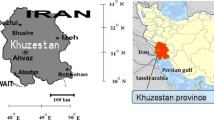Abstract
The primary purpose of this study was to assess water losses by evapotranspiration, evaporation and seepage in arid zone. Normally, evaporation and seepage are the main causes of water losses. For modeling water losses, a combination of Genetic Programming (GP), Penman-Monteith (PM) and Penman combination model for measurement of evapotranspiration, evaporation and seepage has been developed. The results were found to be varying depending on how the evaporation and seepage phenomena are modeled. These results show that that there is an improvement in reducing evapotranspiration, evaporation and seepage losses in arid and semi-arid region.
Similar content being viewed by others
References
Allen RG, Periera LS, Raes D, Smith M (1998) Crop Evapotranspiration: Guidelines for Computing Crop Requirements, Irrigation and Drainage Paper No. 56. FAO, Rome, Italy. p 300.
Armienta H M A, Rodriguez C R (1995) Environmental exposure to chromium compounds in the Valley of Leon, Mexico. Environmental Health Perspectives 103: 47–51.
Aravin VI, Numerov SN (1953) Teoriia dvizheniia zhidkostei i gazov v nedeformiruemoiporistoisrede; Moscow. p 132 (Rusian).
Arnold JG, Sirinivasan R, Muttiah RS, Williams JR (1998) Large area hydrologic modeling and assessment, Part 1: Model development, Journal of The American Water Resources Assocociation, 34(1):73–89
Babovic V, Keijzer M (2000) Rainfall runoff modeling based on genetic programming. Nord Hydrology. 33:331–346.
Chai FJ, Li GY, Zhang Q (2005) Study on effects of irrigation frequency on moisture and salt regime and growth of cotton under mulch-film drip irrigation. Journal of Irrigation and Drainage 24(3): 12–15.
Deutschearu Sschusfsu R, Grenzflachenaktsitovfef E (1960) Original lectures 3rd. int.congress of surface activity. Mainz, Universitätsdruckerei, vol 4.
Discipulus owner’s manual (1998). RML Technologies: Littleton Co. http://www.aimlearning.com [accessed on May 2010]
FAO (1997) Management of Agricultural Drainage Water Quality. Water Report 13. FAO, Rome
Fritschen LJ (1966B) Energy balance method. Paper presented at the american society of agricultural engineers conference on evapo-transpiration and its role in water resources management, Chicago, IL. St. Joseph, MI, pp 34–37
Ganji A, Khalili D, Karamouz M, Ponnambalam K, Javan M (2008) A fuzzy stochastic dynamic nash game analysis of policies for managing water allocation in a reservoir system. Water Research and Management 22:51–66. DOI:10.1007/s11269-006-9143-y.
Guo HM, Wang YX, Shpeizer GM, Yan SL (2003) Natural occurrence of arsenic in shallow groundwater, Shanyin, Datong basin, China. Journal of Environmental Science and Health, Part A: Environmental Science and Engieneering & Toxic and Hazardous Substance Control 38: 2565–2580.
Harboe R, Gautam TR, Onta PR (1994) Conjunctive operation of hydroelectric and thermal power plants. J Water Resour Plan Manage 120(6):778–793. DOI: 10.1061/(ASCE)0733-9496 (1994)120:6 (778).
International Associatioofn Scientifihcy Drology (1963) General Assembly of Berkeiey, Pt. I,. Gentbrugge, Belgium (Publ. no. 62.), pp 7–71.
ISGS (2010) Water pictures: Groundwater seepage. U.S. Department of the Interior U.S. Geological Survey. URL: http://ga.water.usgs.gov/edu/gwdriveway.html [accessed on 22-Dec-2011]
Jensen ME, Burman RD, Allen RG (1990) Evapotranspiration and Irrigation Water Requirements. ASCE Manuals and Reports on Engineering Practices No. 70, p 35.
Khu ST, Liong SY, Babovic V, Madsen H, Muttil N (2001) Genetic programming and its application in real-time runoff forecasting. Journal ofthe American Water Resources Association. 37:439–451. DOI: 10.1111/j.1752-1688.2001.tb00980.x
Koza JR (1992) Genetic programming: on the programming of computers by natural selection. MIT Press, Cambridge, M
Liu XY, Tian CY (2007) Coupling effect of water and nitrogen of cotton under plastic mulching by drip irrigation. Plant Nutrition and Fertilizer Science 13(2): 286–291
Liu RX, Guo WQ, Chen BL (2008) Physiological responses of cotton plant to fertilizer nitrogen at flowering and boll-forming stages under soil drought. Chinese Journal of Applied Ecology 19(7): 1475–1482
Makdessi M, Rahman A, Kibria G (2005) Investigation of the thermodynamic component of penman’s method for estimating evaporation. In: Zerger A, Argent RM (eds) MODSIM..
Monteith JL (1965) Evaporation and environment, In: Proceedings of the 19th Symposium of the Society for Experimental Biology. Cambridge University Press, New York, NY. pp 205–233.
Mosner MS, Aulenbach BT (2003) Comparisons of methods used to estimate lake evaporation for a water budget of Lake Seminole, southwestern Georgia and northwestern Florida.. In K. J. Hatcher (ed.) Proceedings of the 2003 Georgia Water Resources Conference, Institute of Ecology, The University of Georgia, Athens, GA, USA. pp 591–594
Neitsch SL, Amold JG, Kiniry JR, Srinivasan R, Williams JR (2005) Soil and Water Assessment Tool SWAT Theory, Version 2005, USDA Agricultural Research Service and Texas A&M Blackland Research Center Temple, Texas.
Penman HL (1948) Natural evaporation from open water, bare soil and grass. Proc R Soc Lond A Math Phys Sci 193(1032):120–145. DOI:10.1098/rspa.1948.0037
Penman HL (1948) Natural evaporation from open water, bare soil, and grass. Proceedings of the Royal Society, London A193. pp 120–146.
Ritchie JT (1972) Model for predicting evaporation from a row crop with incomplete cover. Water Resources Research., 1204–1213
Schulman NJH (1957) Proc. 2nd Inc. Congr. of Surface Activity, London, Butterworths Scientific Publications, vol. 1, p 259–280.
Shchelkachev VN, Lapuk BB (1949) Podzemnaiagidravlika. Moscow-Leningrad, p 142
Shiau JT, Lee HC (2005) Derivation of optimal hedging rules for a water-supply reservoir through compromise programming. Water Resources Management 19:111–132. DOI: 10.1007/s11269-005-1502-6
Sivapragasam C, Maheswaran R, Veena V (2006) Genetic programming approach for flood routing in natural channels. Hydrological Process 22(5):623–628. DOI:10.1002/hyp.6628
Sun YH, Yang SL, Yeh WWG, Louie PWF (1996). Modeling reservoir evaporation losses by generalized networks. Journal of Water Resoucres and Planning and Management. 122(3):222–226. DOI: 10.1061/(ASCE)0733-9496(1996)122: 3(222)
Walter IA, Allen RG, Elliott R, Mecham B, Jensen ME, Itenfisu D, Howell TA, Snyder R, Brown P, Echings S, Spofford T, Hattendorf M, Cuenca RH, Right JL, Martin D (2000)ASCE standardized reference evapotranspiration equation, in: Evans, R.G., Benham, B.L., Trooien, T.P. (Eds.), Proceedings of the National Irrigation Symposium, ASAE, Nov. 14–16, Phoenix, AZ. pp 209–215.
Wang R, Wang Y, Guo H (2001) Hydrogeochemistry of shallow groundwaters from the northern part of the Datong basin. In Proc. 9th Internat. Symp. Water-Rock interaction, ed. Cidu R. A.A.Balkema, Rotterdam. pp 605–608.
Wang YX, Guo HM, Yan SL, Wang RF, Li YL (2004) Geochemical evolution of shallow groundwater systems and their vulnerability to contaminants: A case study at Datong Basin, Shanxi province, China. Science Press Beijing. pp 123–130
Wegner D (1999) A report on evaporation and ground water seepage. In: Columbia EARTHSCAPE (An online resource on the global environment). http://www.earthscape.org /p2/hp/hp_win99/hp_win99c.html [accessed on July 2010]
Woolley T (1962) Soil-applied hexadecanol as an evapotranspiration suppressant.’ Journal of Soil and Water Conservation., vol. 17, no. 3, p. 130.
Xie X, Wang YX, Andre DE (2008) Sources and mobilization processes of arsenic in the shallow aquifers of the Datong Basin. PhD dissertation, China Univesrity of Geosciences, Wuhan, P.R. China. p78
Xie X, Wang YX, Duan M, Liu H (2009) Sediment geochemistry and arsenic mobilization in shallow aquifers of the Datong basin, northern China. Environmental Geochemistry and Health 31: 493–502. DOI: 10.1007/s10653-008-9204-7.
Yang GY, Luo YP, Li BG (2003) Effect of different soil water condition growth of root and shoot of winter wheat. Agricultural Research in the Arid Areas 21(3): 104–109
Yang GY, Luo YP, Li BG (2006) The effects of sustaining time of watering stress on root and shoot weight accumulation in winter wheat. Agricultural Research in the Arid Areas 24(4): 94–98
Yang ZB, Chen BL, Zhou ZG (2008) Effects of nitrogen application rate on spatiotemporal variability of biomass accumulation of cotton’s fruiting branch at flower and boll stage. Chinese Journal of Applied Ecology 19(10): 2215–2220.
Author information
Authors and Affiliations
Corresponding author
Rights and permissions
About this article
Cite this article
de la Paix Mupenzi, J., Li, L., Ge, J. et al. Water losses in arid and semi-arid zone: Evaporation, evapotranspiration and seepage. J. Mt. Sci. 9, 256–261 (2012). https://doi.org/10.1007/s11629-012-2186-z
Received:
Accepted:
Published:
Issue Date:
DOI: https://doi.org/10.1007/s11629-012-2186-z




